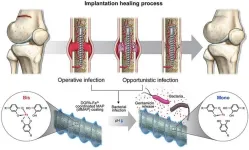Protecting joints from bacteria with mussels
2024-03-05
(Press-News.org) Degenerative arthritis is no longer exclusive to the elderly population. According to the National Health Insurance Service report covering the years from 2012 to 2022, there has been a 22.8% increase in the prevalence of degenerative arthritis among people in their 20s and 30s. This rise is attributed to prolonged periods of desk sitting and the excessive lifting of heavy sports equipment, both of which can lead to significant cartilage damage. While artificial joints are a common treatment, bacterial infections have posed challenges. However, a recent study has proposed an intriguing solution involving the use of mussels.
A collaborative research team, comprising of Professor Hyung Joon Cha from the Department of Chemical Engineering and the School of Convergence Science and Technology and Dr. Hyun Sun Choi from the Department of Chemical Engineering at Pohang University of Science and Technology (POSTECH), and Professor Yun Kee Jo from the Department of Biomedical Convergence Science and Technology of the College of Advanced Technology Convergence at the Kyungpook National University, has successfully developed a coating material for implants. This material, based on mussel adhesion proteins, is designed to release antibiotics in response to bacterial invasion. The research has been recently published in the online edition of Biomaterials, a prominent international journal in the field of biomaterials.
In implant procedures, bacterial infections not only compromise the stability of the implant but also give rise to various complications. Moreover, highly antibiotic-resistant bacteria often lead to recurrent infections even after antibacterial treatment, requiring additional procedures. While there has been active exploration of implant coating materials with antibiotics, numerous challenges have emerged including physical damage to the material during the procedure and potential leakage of antibiotics inside.
In this research, the team directed their attention to DOPA, one of the amino acids found in mussel adhesion proteins. DOPA, crucial for the robust adhesion observed in mussels, forms potent bonds with metal ions. Its interaction with ferrous metal ions is notable because it weakens as the acidity (pH) decreases. Recognizing that bacterial invasion alters the body's acidity, the team developed a novel implant coating material.
This material contains antibiotics under normal conditions, but in the event of a bacterial infection and subsequent acidification, it releases 70 percent of the antibiotics within eight hours, effectively eliminating the bacteria. Notably, the material exhibits remarkable durability, showcasing immediate antibacterial efficacy even during the bone regeneration phase (approximately four weeks) following the implant procedure.
The quantity of antibiotics discharged by the material corresponds to the extent of bacterial infection, and the researchers additionally validated the antibacterial efficacy of the coating material based on varying bacterial concentrations. Particularly, the bond between DOPA and iron ions showed remarkable resilience to external physical stimuli, rendering it resistant to abrasion and mechanical loads encountered during the implantation process.
Professor Hyung Joon Cha of the POSTECH who led the study expressed his expectation by saying, "The immediate and sustained antimicrobial effect of the adhesive implant coating material has the potential to significantly enhance the success rate of implant procedures." Professor Yun Kee Jo of the Kyungpook National University added, explaining the significance of the research, "By releasing antibiotics selectively in response to actual need, this could represent a groundbreaking technology in preventing the emergence of superbacteria in the future."
The research was conducted with support from the Korea Health Technology R&D Project and the Dentistry Technology R&D Project of the Ministry of Health and Welfare, the Mid-Career Research Program and the Young Researcher Program of the Ministry of Science and ICT, and POSCO Holdings.
END
ELSE PRESS RELEASES FROM THIS DATE:
2024-03-05
Researchers at Friedrich-Alexander-Universität Erlangen-Nürnberg (FAU) and Universitätsklinikum Erlangen have examined a man who has received more than 200 vaccinations against Covid-19. They learned of his case via newspaper reports. Until now, it has been unclear what effects hypervaccination such as this would have on the immune system. Some scientists were of the opinion that immune cells would become less effective after becoming used to the antigens. This proved not to be the case in the individual in question: his immune system is fully functional. Certain immune cells and antibodies against SARS-CoV-2 are even ...
2024-03-05
New research from Flinders University has revealed that parents are feeling conflicted, confused and concerned when it comes to zero-alcohol beer, wine and spirts and adolescents.
In recent years alcohol-free alternatives have flooded the Australian drinks market, reaching into the millions of dollars and heralding a new - but ever more confusing - era for parents across the country.
With such a meteoric rise in choice and popularity, the rules, regulations and wider implications of these drinks for adolescents are still being studied.
Non-alcoholic beer, wine, and spirits, sometimes known as ...
2024-03-05
USC will spark new startups and innovation under a new collaboration with Techstars, a leading pre-seed investor.
The collaboration is also promising for the local economy as ideas generated at USC are converted into products and businesses that will enhance the university’s economic footprint at “Silicon Beach.” The budding tech corridor spans Los Angeles County and portions of Orange County, and it hosts several tech and biotech industry leaders, including the USC Information Sciences Institute in Marina del Rey and the USC Institute for Creative Technologies in Los Angeles.
“Our mission is to ...
2024-03-05
Secure firearm storage—storing a firearm unloaded, locked and separate from ammunition—can help reduce the risk for suicide, but many military service members store their firearms unsecured.
In a new Rutgers Health study, researchers asked firearm-owning service members who they view as the most credible sources to discuss secure firearm storage for suicide prevention.
The researchers, whose study appears in the journal Suicide and Life-Threatening Behaviors, examined data from 719 U.S. service members.
“There is no single voice that will appeal to all firearm-owning service members, but certain groups are widely seen as credible overall and our results ...
2024-03-05
*This is an early press release from the European Congress on Obesity (ECO 2024) Venice 12-15 May. Please mention both the Congress and the journal Diabetologia if using this material*
New research being presented at this year’s European Congress on Obesity (ECO) in Venice, Italy (12-15 May), and published in Diabetologia (the journal of th European Association for The Study of Diabetes [EASD]) suggests that having a low birthweight together with being overweight in young adulthood (but not childhood) contributes to the development of type 2 diabetes at an early age (59 years or younger) in men.
Notably, the study involving over 34,000 ...
2024-03-04
Researchers from North Carolina State University have developed a new generation of high-performance DNA aptamers and highly accurate drug sensors for cocaine and other opioids. The sensors are drug specific and can detect trace amounts of fentanyl, heroin, and cocaine – even when these drugs are mixed with other drugs or with cutting agents and adulterants such as caffeine, sugar, or procaine. The sensors could have far-reaching benefits for health care workers and law enforcement agencies.
“This work can provide needed updates to currently used tests, both in health care and law enforcement settings,” ...
2024-03-04
The City University of New York (CUNY) Institute for Implementation Science in Population Health (ISPH) and the CUNY Graduate School of Public Health and Health Policy (CUNY SPH), in collaboration with Pfizer, are initiating a critical two-year prospective epidemiologic study in the spring of 2024 to track acute respiratory infections across the United States.
Project PROTECTS (Prospective Respiratory Outcomes from Tracking and Evaluating Community-based TeSting) builds on the pivotal CHASING COVID Cohort Study, which has monitored SARS-CoV-2 infection rates and associated risk factors through questionnaires and at-home serological testing since March 2020. The cohort's ...
2024-03-04
Menlo Park, CA: SRI announced today the relaunch of PARC Forum, an event and program series that brings together some of the world’s leading thinkers for thought-provoking conversations at the intersection of technology and society.
The first PARC Forum event marks the first anniversary of SRI’s acquisition through a donation from Xerox of the Palo Alto Research Center (PARC ). The acquisition brought together two iconic Silicon Valley organizations that have created and delivered technologies, services, and ideas that have had a profound impact on every one of our lives.
SRI’s ...
2024-03-04
Beech trees provide food for animals, timber for wood products, and sustenance for beech drop plants, but they are under threat from Beech Leaf Disease (BLD). The disease, first documented in 2012 in the Midwest, is associated with the nematode Litylenchus crenatae mccannii and is spreading rapidly throughout the central and northeast regions of North America.
A team of scientists led by Craig Brodersen, professor of plant physiological ecology, and Leila Fletcher, postdoctoral associate, at the Yale School of the Environment has uncovered ...
2024-03-04
Medical diagnostics expert, doctor’s assistant, and cartographer are all fair titles for an artificial intelligence model developed by researchers at the Beckman Institute for Advanced Science and Technology.
Their new model accurately identifies tumors and diseases in medical images and is programmed to explain each diagnosis with a visual map. The tool’s unique transparency allows doctors to easily follow its line of reasoning, double-check for accuracy, and explain the results to patients.
"The idea is to help catch cancer and disease in its earliest stages — like an X on ...
LAST 30 PRESS RELEASES:
[Press-News.org] Protecting joints from bacteria with mussels





